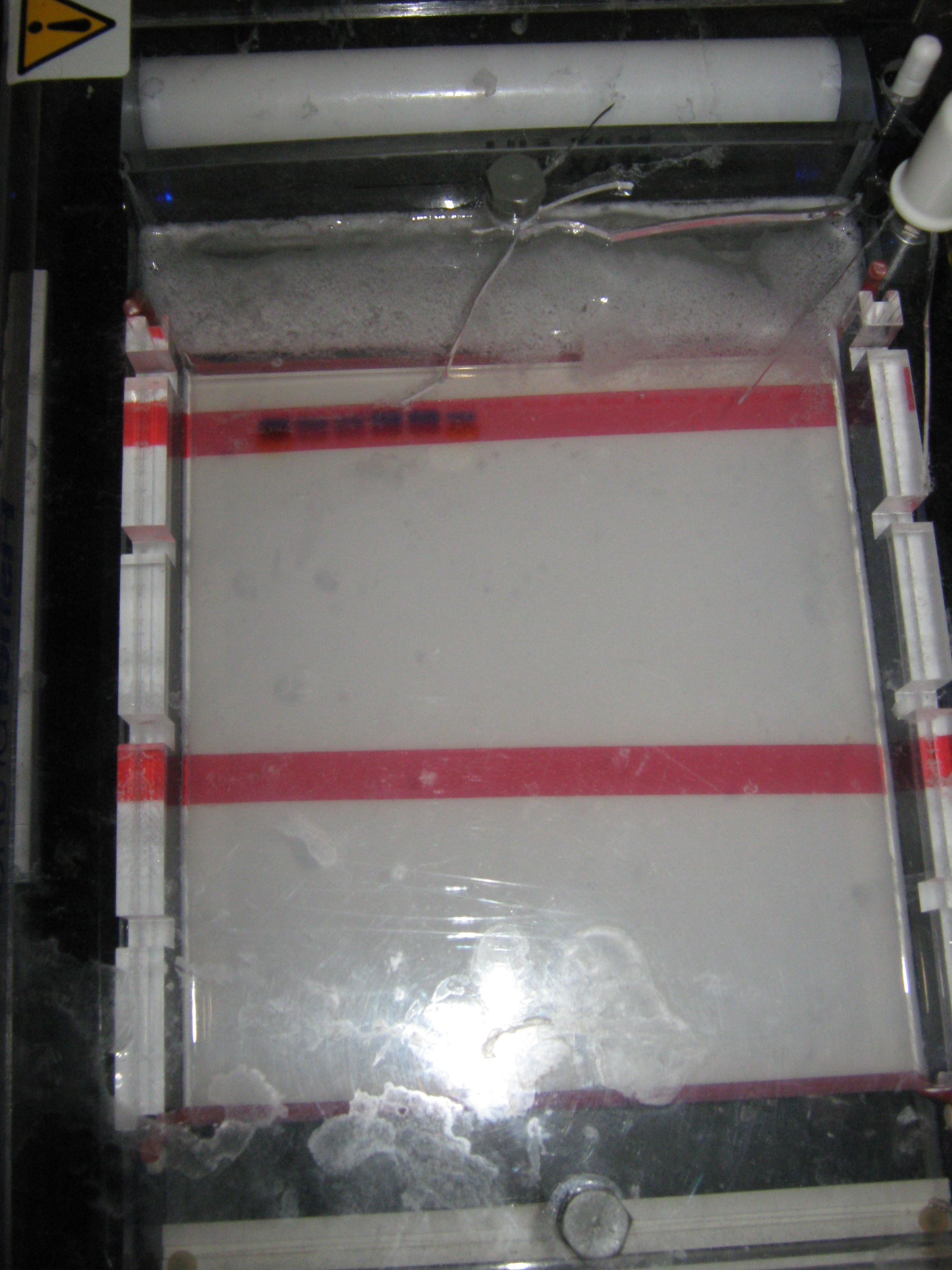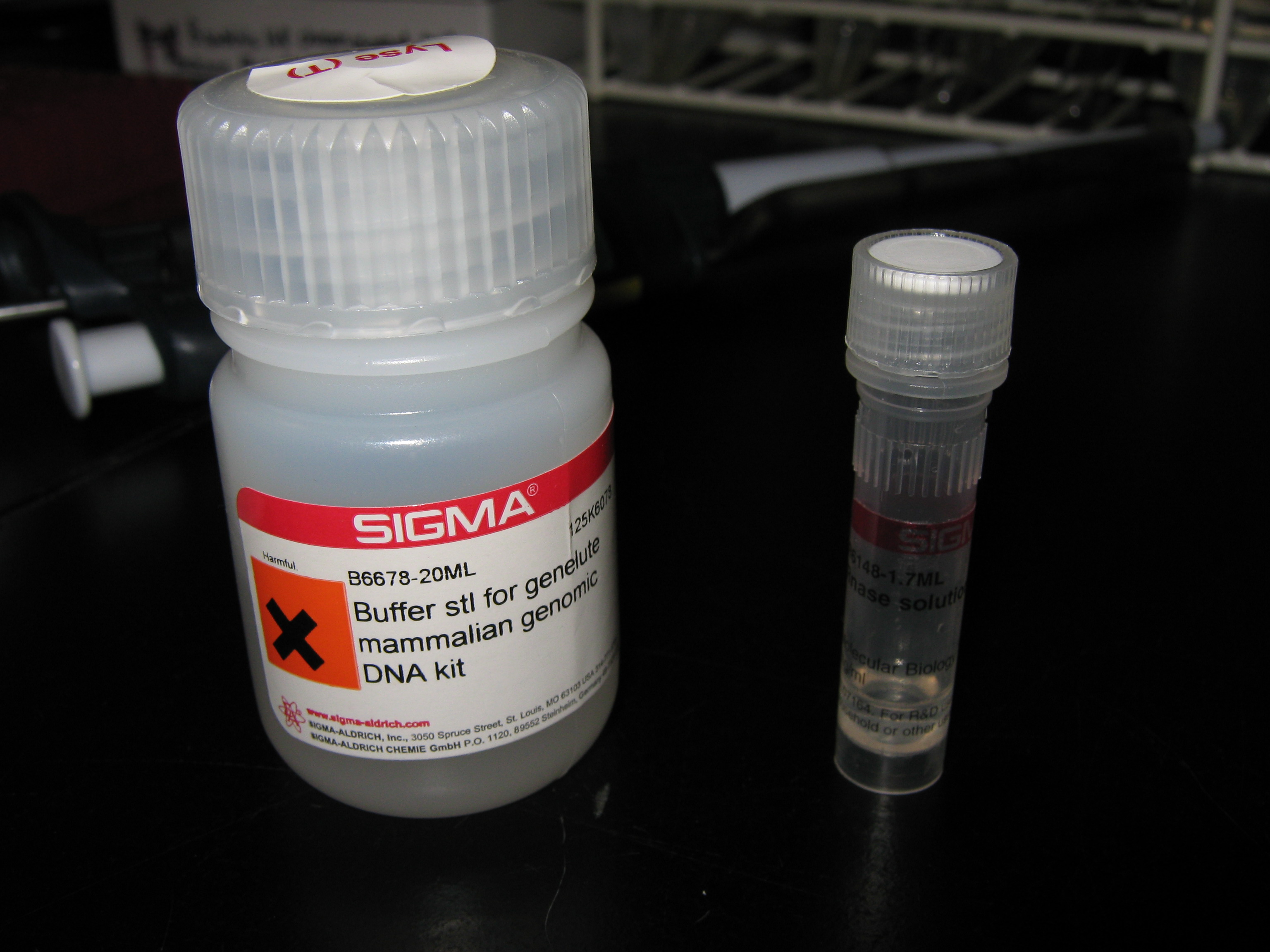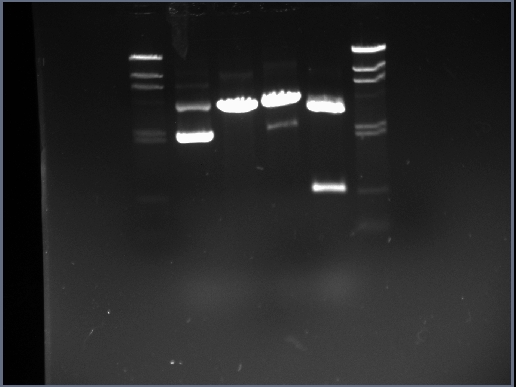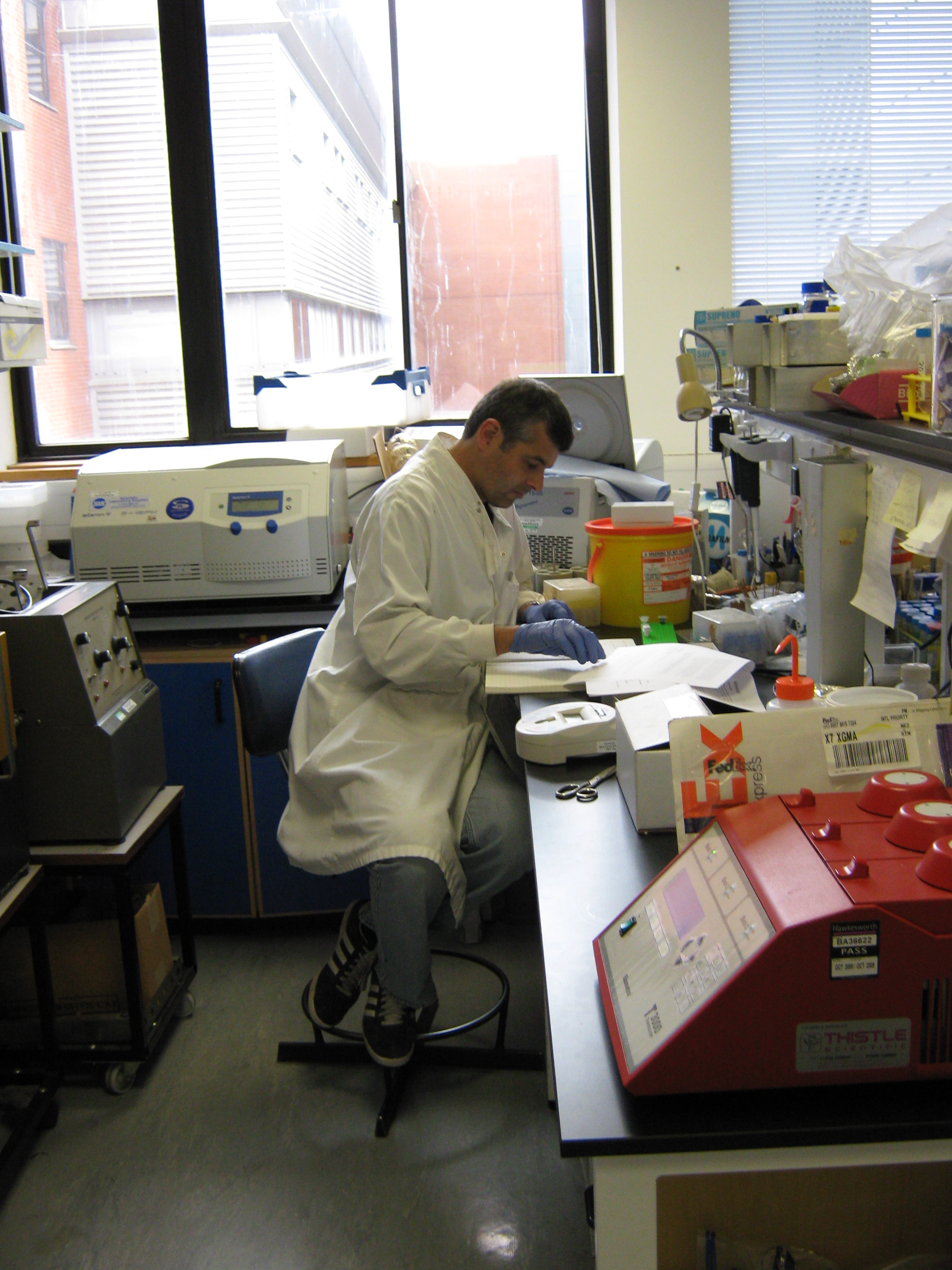Team:Newcastle/Labwork/27 August 2009
From 2009.igem.org
Babyneurone (Talk | contribs) (→Isolating promoter-less BBa_J33206 in plasmid pSB1A2) |
Babyneurone (Talk | contribs) (→Summary) |
||
| Line 20: | Line 20: | ||
===Summary=== | ===Summary=== | ||
[[Image:Team Newcastle 2009 iGEM 27-08-09 IMG 0544.JPG|200px|thumb|The buffer and RNAse solutions needed for genomic preparations]] | [[Image:Team Newcastle 2009 iGEM 27-08-09 IMG 0544.JPG|200px|thumb|The buffer and RNAse solutions needed for genomic preparations]] | ||
| - | + | ||
Today Goksel did a restriction digest of our plasmid backbone (pSB1AT3) cutting out the mCherry coding sequence. This will prepare the backbone for the PCR products of ara, sac and sspb, which we intend to build as a construct within this plasmid. The sample was run on a gel and, using the transilluminator, the correct band was cut out of the gel. This can be purified tomorrow. | Today Goksel did a restriction digest of our plasmid backbone (pSB1AT3) cutting out the mCherry coding sequence. This will prepare the backbone for the PCR products of ara, sac and sspb, which we intend to build as a construct within this plasmid. The sample was run on a gel and, using the transilluminator, the correct band was cut out of the gel. This can be purified tomorrow. | ||
Latest revision as of 12:08, 20 August 2010
Formal Lab Session - 27th August 2009
Overview
- Stochastic Switch Team - digested the pSB1AT3 plasmid backbone (removing mCherry), ran products through gel and then excised fragment. Also did a genomic DNA prep for Bacillus subtilis cells (grown overnight)
- Metal Sensor Team - carried out a further attempt at digesting the BBa_J33206 BioBrick; also made a real start on the cadmium-sensor AND gate by digesting BBa_J33206 in pSB1A2, consequently removing the promoter, and excising the backbone fragment from agarose gel.
- Promoter Library Sub-Project - attempted to remove the pGFP-rrnB backbone fragment (digested yesterday) from agarose gel - yesterday's digests didn't work properly so second attempt made
Stochastic Switch team
Summary
Today Goksel did a restriction digest of our plasmid backbone (pSB1AT3) cutting out the mCherry coding sequence. This will prepare the backbone for the PCR products of ara, sac and sspb, which we intend to build as a construct within this plasmid. The sample was run on a gel and, using the transilluminator, the correct band was cut out of the gel. This can be purified tomorrow.
Today we also did a Genomic DNA prep for E.coli. We need this for our PCR reaction in order to get the sspb degradation controller protein. We used the gram negative protocol provided in the kit. Yesterday we set up 2 ON cultures for DH5alpha E.coli:
- We spun down the cultures to pellet them, and aspirated the media.
- The pellet was resuspended in lysis solution T
- For RNA free DNA we added RNAse and incubated for 20 minutes.
- Proteinase K was then added and the solution incubated in the waterbath for 30 minutes at 55C
- Then the Lysis solution C was added and was incubated for a further 10 minutes at 55C
- During this time the column was prepared to the binding column.
- Ethanol was added to our solution and the bind, wash and elution steps were carried out as the protocol suggested.
[http://www.sigmaaldrich.com/etc/medialib/docs/Sigma/General_Information/na_2100.Par.0001.File.tmp/na_2100.pdf Sigma Genelute Bacterial Genomic DNA kit protocol]
We will run our results on a gel tomorrow as well as analysing them on the nanadrop in order to determine DNA concentration and quality.
Restriction digest
Before we start using pSB1AT3+mCherry from the midipreps we diluted the tube with 100ul of water. We then followed the steps to cut the plasmid from EcoRI and SpeI sites to remove the biobrick. The plasmid backbone will be used for our parts later on.
- 15ul of water
- 4ul of fast digest buffer
- 15ul of DNA(pSB1AT3)
- 3ul of fast digest EcoRI
- 3ul of fast digest SpeI
After mixing everything we added 50ul of the loading buffer to make the final volume 50ul.
Running the gel
We prepared the gel with large wells to be able t load 50ul. We used 10ul of DNA ladder.
We then cut the gel fragment containing the plasmid backbone.
The fragment was placed in an ependorf tube and weighed as 184mg. It was then placed into the fridge for tomorrow.
Metal Sensor Team
Introduction
In yesterday's lab session, the Metal Sensing Team attempted to digest the BBa_J33206 BioBrick within plasmid pSB1A2 with FastDigest restriction enzymes EcoRI and PstI. It was our first attempt in using this brand of enzymes, which should have only taken 5 minutes to digest. However the digests didn't work and this was done to a couple of reasons: a) there was too much DNA to digest and b) even the 10 minute digestion period was not long enough.
In today's lab session the team will conduct a second attempt of the digests and hopefully analyse them by DNA gel electrophoresis today also. As well as this the team needs to begin acting on the cloning strategy for the cadmium-sensing AND gate (i.e. placing the cadA promoter region next to the arsR binding site) by excising the BBa_J33206 + pSB1A2 backbone (which will have it's original promoter removed) out of gel and purifying the fragment.
Practical Outline
Here are the tasks the Metal Sensing Team hope to complete by today's lab session
- Carry out a second attempt at digesting the BBa_J33206 in pSB1A2 BioBrick with EcoRI alone, PstI alone and then with EcoRI+PstI and running the fragments on gel.
- For the cadmium-sensing AND gate, digest 10ul of BBa_J33206 (in plasmid pSB1A2) and excise the backbone fragment out of gel.
Procedure
Second Attempt at digesting BBa_J33206 in plasmid pSB1A2
For the second attempt at digesting the pSB1A2 plasmid the Metal Sensing team decided to still use the FastDigest enzymes EcoRI and PstI as well as the FastDigest enzyme buffer in the procedure. However this time round, the team took the decision to digest less DNA and to also allow the digests to run for about 1 hour under 37C incubation. Below is a table showing all of the contents of the various digests:
| pSB1A2 alone | pSB1A2 + EcoRI | pSB1A2 + PstI | pSB1A2 + EcoRI + PstI | |
|---|---|---|---|---|
| DNA (ul) | 2 | 2 | 2 | 2 |
| Restriction Buffer (ul) | 2 | 2 | 2 | 2 |
| Restriction Enzyme(ul) | 0 | 1 | 1 | 2 |
| Distilled water(ul) | 16 | 15 | 15 | 10 |
The digests were then left for an hour to ensure complete digestion. After this they were loaded in agarose gel and placed under DNA gel electrophoresis. The gel was analysed using the GelDoc system and the photograph produced can be seen under the 'Results' section.
Isolating promoter-less BBa_J33206 in plasmid pSB1A2
The next item on the team's agenda was to digest the BBa_J33206 in plasmid pSB1A2 DNA to such an extent that the original promoter is removed - this is to allow the team to later ligate the cadA promoter region into the BioBrick. This digest would then be run on gel with the backbone fragment excised and eventually cleaned up.
The digest itself involved 10ul of BBa_J33206 (in plasmid pSB1A2) DNA being cut with enzymes ' and '. The total volume of the mixture was 40ul:
- 10ul of BBa_J33206 DNA
- 2ul of '
- 2ul of '
- 4 ul of Buffer solution
- 12ul of sterile distilled water
1 hour was given for the digest to take place under 37C incubation in the water bath. After this period was over the 40ul of digest solution was then placed in 0.8% agarose gel and run for only 20 minutes under 60 volts - this is to ensure that the band doesn't run too far.
When we took the gel to the dark room, the gel was exposed to UV light - this made the backbone fragment glow enabling us to cut it out correctly. The gel slice was then placed in an Eppendorf tube for gel extraction tomorrow.
Results
The image above immediately shows the digests have been successful this time - clear bands are present. When the plasmid is linearised twice (once by EcoRI and once by PstI) it can be seen that the bands produced are larger than the size anticipated for the linearised plasmids - the expected size is 3035bp and the band lies just below the 4361bp band produced by the HindIII ladder. This seems to be an erroneous result.
However when both EcoRI and PstI are applied to the DNA the small fragment seems to be a lot shorter than the expected size - the team expects a 936bp fragment whereas the fragment produced rather resembles the 564bp fragment of the HindIII ladder. This is also erroneous!
The reason for the DNA looking like this will be investigated further.
Promoter Library Sub-Project
Introduction
Yesterday's lab session saw pGFP-rrnB DNA being cut with restriction enzymes EcoRI and NheI which is now stored in the -20C freezer. For today's lab session, we hope to run the enzyme digested pGFP-rrnB products on agarose gel (also made yesterday) and use this analytical procedure to isolate the 7995Kb plasmid fragment. Once the fragment has been determined by exposure to ultra-violet light, we hope to cut it out of the gel and extract the DNA from the agarose using a gel extraction kit.
Extracting the 8Kb fragment
40ul of the DNA + restriction enzyme solution was run on the gel for about 10-20 minutes under 70mv before the electrophoresis was stopped. The gel was then taken to the dark room (where the gel analysis equipment is kept) and under UV light, the fluorescing band found at the top of the well was cut out of the gel. The fragment was then placed in an Eppendorf tube for the gel extraction process. Although the heavier band was taken for processing, it has to be said that we were unconvinced that the digestions had worked properly; the bands we had expected to see did not emerge and the probable reason for this the time these enzymes had to operate. The FastDigest enzymes had been used and despite the protocol suggesting these enzymes take 5 minutes to digest, the bands seemed to show otherwise.
Meanwhile, the 8kb fragment of DNA was prepped using the gel extraction kit; the end solution was 50ul eluted plasmid DNA which is now stored in the -20C freezer.
Another attempt at digesting pGFP-rrnB with EcoRI and NheI
Once this had been accomplished, another attempt to digest the pGFP-rrnB plasmid DNA with the enzymes EcoRI and NheI was made to make sure that the enzymes work correctly if given enough time to operate. However it was decided that the contents of the digest mixture would be altered slightly to assure complete digestion:
- 4ul of EcoRI
- 4ul of NheI
- 10ul of pGFP-rrnB DNA
- 4ul of FastDigest buffer
- 28ul of sterile distilled water
Instead of allowing just 1 hour under incubation these digests were given 2 hours to digest under incubation. The resulting digest solution was then placed in the freezer for storage.
Further digests of the pGFP-rrnB DNA
In addition to carrying out this confirmation digest, we digested pGFP-rrnB plasmid DNA with EcoRI and NheI enzymes but on an individual basis. We prepared 10ul each for the 2 different enzymes and had them stored in the -20C freezer.
|
| |||||||||||||||||||||||||||||||||||||||||||||||||||||||||||||||||||||||||||||||||||||||||||||||||
|
| |||||||||||||||||||||||||||||||||||||||||||||||||||||||||||||||||||||||||||||||||||||||||||||
News
Events
- 20 – 21 June 2009 - Europe workshop (London)
- 23 – 24 June 2009 - UK iGEM meetup (Edinburgh)
- 23 October Practice Presentation (Newcastle)
- 23 October T-shirts are ready
- 27 October Practice Presentation (Sunderland)
- 27 October Poster is ready
- 30 October – 2 November 2009 - Jamboree (Boston)
Social Net
- Newcastle iGEM Twitter
- [http://www.facebook.com/home.php#/group.php?gid=131709337641 Newcastle on Facebook]
- [http://www.youtube.com/user/newcastle2009igem Newcastle Youtube Channel]
 "
"







